Mil Mi-8 Videos
|
Loading...
|
|
Mil Mi-8
Mi-8
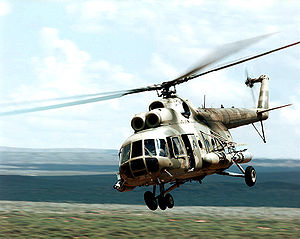
Picture - Mil Mi-8 of the USAF 6th Special Operations Squadron during a military exercise
Role: Transport helicopter
Manufacturer: Mil Moscow Helicopter Plant
Kazan Helicopter Plant
First flight: 7 July 1961
Introduced: 1967
Status: In service
Primary users: Soviet Union (historical)
ca. 80 other countries, see Operators below
Produced: 1961-
Number built: >17,000
Unit cost: $5-8 million (2006)
Variants: Mil Mi-14
Mil Mi-17
The Mil Mi-8 (Russian ŠŠø-8, NATO reporting name "Hip") is a medium twin-turbine transport helicopter that can also act as a gunship. The Mi-8 is the world's most-produced helicopter, and is used by over 50 countries. Russia is currently the largest active operator of the Mi-8/Mi-17 helicopter.
Design and development
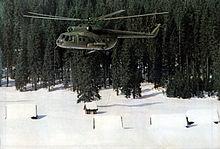
Picture - Mi-8T helicopter of YuAF.
The prototype V-8 was designed in 1960 based on the Mil Mi-4 with a larger cabin. Powered by a 2,010 kW (2,700 shp) Soloviev turboshaft engine, the V-8 first flew in July 1961. The second prototype equipped with two 1,120 kW (1,500 shp) Isotev TV2 engines, made its first flight on 17 September 1962. For the production version the rotor was changed from a four blades to five blades in 1964. After a few changes it was introduced into the Soviet Air Force by 1967 as the Mi-8.
There are numerous variants, including the Mi-8T which is armed with rockets and anti-tank guided missiles, in addition to carrying 24 troops. The Mil Mi-17 export version is employed by around 20 countries; its equivalent in Russian service in the Mi-8M series. The naval Mil Mi-14 and attack Mil Mi-24 are also derived from the Mi-8. The Mi-8 remains in production in 2009.
Operational history
Yugoslavia
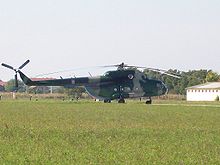
Picture - Croatian Mil Mi-8MTV-1
The Yugoslav Air Force bought 24 Mi-8T (Hip C) transport helicopters from May 1968 to May 1969 to equip two squadrons of the newly formed 119th transport regiment from Ni military airport, each squadron with 12 helicopters. Subsequently, from 1973 to the early 1980s, Yugoslavia purchased more Mi-8T helicopters to re-equip two squadrons of 111th regiment from Pleso military airport near Zagreb and the 790th squadron from Divulje military airport near Split, which was under the command of the Yugoslav Navy. In total, the Yugoslav Air Force received 92 Mi-8T transport helicopters from Soviet Union, known formally to the military as the HT-40, while local modification of several helicopters into electronic warfare variants produced the HT-40E. Some 40 helicopters were equipped for firefighting operations.
The Yugoslav Mi-8s' first combat operations were transport of army troops and federal police forces to border crossings in Slovenia on 27 June 1991. The members of Slovenian Territorial Defence fired Strela 2 MANPAD, and shot one helicopter down, killing all crew and passengers.
Picture - Serbian Mi-8T cargo helicopter
During combat in the winter of 1991 in Croatia and in the spring of 1992 in Bosnia and Herzegovina, Yugoslav People's Army used the Mi-8 fleet for evacutaion of injured personnel, transport of cargo and search and rescue of crews of aircraft forced down. As the most of flights were made behind the front, the Croatian forces were able to down one only helicopter, hit with small arms fire near Slavonski brod on 4 October 1991.
After Bosnian Serbs declared their state in the spring of 1992, some former Yugoslav Air Force Mi-8s continued service in new armed forces. The inventory of the 82nd mixed helicopter squadron of 92nd aviation brigade of Army of Republika Srpska contains 12 Mi-8T helicopters which continued in service until Operation Koridor. During that period, the Republika Srpska Air Force lost 3 Mi-8 helicopters to enemy fire. Three helicopters painted in a blue and white colour scheme flew in the first part of 56th helicopter squadron of Krajina Milicija, using Udbina military airport in Lika as their main base. The Republika Srpska Air Force continued to operate 9 helicopters, albeit suffering problems with maintenance and spare parts, until it was formally disbanded in 2006.
On the other side, Mi-8 helicopters were also used as main air transport. Croatian National Guard obtained their first on 23 September 1991, near Petrinja, when a Yugoslav Air Force Mi-8 made an emergency landing after being damaged by small-arms fire. A further 6 Mi-8T and 18 Mi-8MTV-1 helicopters were bought from ex-Warsaw Pact countries during the war, but only 16 of those survived the war. The remaining Mi-8Ts were retired from service in the Croatian Air Force after the war, while the Mi-8MTVs continued their service in 20th Transport Helicopter Squadron, and 28th Transport Helicopter Squadron. The latter has been re-equipped with new Mi-171Sh helicopters bought from Russia.
The Army of the Republic of Bosnia and Herzegovina secretly obtained Mi-8T, Mi-8MTV and Mi-17 helicopters from various sources. Bad aircrew training cost Muslim forces half of their helicopters. Two helicopters were shot down by Serbian air defences, one around Žepa, while one Mi-17 was shot down by 2K12 Kub M, killing the Bosnian Minister Irfan LjubijankiÄ, a few other politicians, and the helicopter's Ukrainian mercenary crew. A few Croatian Mi-8MTVs secretly supported Croatian Defence Council operations in Herceg Bosna. After the war, the Army of the Federation of Bosnia and Herzegovina operated the remaining 5 Mi-8MTV's and 1 Mi-8T in the Air Force and Air Defense Brigade of Armed Forces of Bosnia and Herzegovina.
Finally, the Macedonian Air Force bought 4 Mi-17V-1 in 1994 and 2 Mi-8MT helicopters in 2001 from the Ukraine. They fly in the Transport Helicopter Squadron (ex 301. Transport Helicopter Squadron). One crashed, killing all 8 passengers and 3 crew members in an accident in January 2008. In May 2008 Macedonia acquired 4 additional Mi-171, purchased from Lithuania.
During the 1998-1999 Kosovo war, the Yugoslav Air Force used Mi-8s for transport of personnel and material to forces in otherwise-inaccessible mountain areas. Evacuation of injured personnel also occurred during the 1999 NATO bombing of Yugoslavia, flying at low altitude to avoid detection by NATO aircraft. Two Mi-17V helicopters which were secretly operated by the Unit for Special Operations post-1997 were also active during the Kosovan conflict. After the disbanding of the unit in 2003, the helicopters were transferred to Air Force.
Today the Serbian Air Force, successor of Yugoslav Air Force, operates between 6-8 Mi-8T and 2 Mi-17 helicopters in the 138th Mixed-Transport-Aviation Squadron of 204th Air Base and 119th Combined-Arms Helicopter Squadron (ex 199th regiment) of 98th Air Base.
Finland
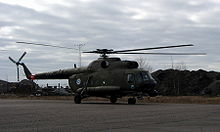
Picture - Finnish Mi-8 in Hernesaari, Helsinki, in 2005
The Finnish Defence Forces and the Finnish Border Guard have been using Mi-8s since the 1970s, with the Finnish Air Force receiving its first, serialed HS-2, on May 28, 1973, and the second, HS-1, on May 31, 1973. Six Mi-8Ts were obtained at first, followed by further two Mi-8Ts and two Mi-8Ps. Three of the helicopters were handed over to the Border Guard Wing. One of these was lost after sinking through ice during a landing. It was soon replaced by a new Mi-8. After their Border Guard service, the helicopters were transferred to the civil register, but shortly thereafter to the Air Force. In 1997 it was decided that all helicopters, including the remaining five Mi-8Ts and two Mi-8Ps, should be transferred to the Army Wing at Utti. All Mi-8s have now been replaced with NH90 helicopters. One Mi-8 is on display at the Finnish Aviation Museum in Vantaa, and one is at the Px¤ijx¤nne Tavastia Aviation Museum in Asikkala, near Lahti.
Others
Between April and May 1986 many of these machines were used to drop radiation-absorbing materials into the 4th reactor of Chernobyl Nuclear Power Plant after the explosion. Most of them were severely irradiated and abandoned in the giant junkyard (so-called "machines cemetery") near Chernobyl. One crashed near the power plant after hitting the crane's lines; everyone onboard perished.
In Afghanistan, there are several civilian versions flying cargo contracts for the US Army.
On 15 October 2006, India agreed to acquire 80 Mi-17 helicopters from Russia in a deal worth approximately US$662 million.
On 19 July 2009 a Mil Mi-8 helicopter crashed at Kandahar Air Field during takeoff killing 16 aboard and injuring 5. The helicopter was owned by Vertikal-T, a Russian air transportation company.
On July 2, 2008, two Mi-17 were used to rescue 15 hostages during the Operation Jaque performed by the Colombian military.
Variants
Prototypes/experimental/low production rate variants
V-8 (NATO - Hip-A)
The original single-engined prototype.
V-8A
A twin-engined prototype, featuring TV2-117 turboshaft engines, the prototype underwent further modifications during its life.
V-8AT
Prototype of the Mi-8T utility version.
Mi-8 (NATO - Hip-B)
Twin-engined prototype.
Mi-8TG
Conversion to operate on LPG gas.
Mi-18
Prototype design, a modification of the existing Mil Mi-8. Two Mi-8s were extended by 0.9 meters (3 ft), the landing gear made retractable, and a sliding door added to the starboard side of the fuselage. The Mi-18s were used in the Soviet invasion of Afghanistan, and later used as static training airframes for pilots of the Mi-8/17.
Basic military transport/airframe variants
Mi-8T (NATO - Hip-C)
First mass production utility transport version, it can carry four UV-16-57 unguided rocket pods, (with S-5 rockets), on four weapons pylons on two sub-wings, and is armed with one or two side mounted PK machine guns.
Mi-8TV
Armed version of the Mi-8T.
Mi-8TVK (NATO - Hip-E, aka Mi-8TB)
Version used as a gunship or direct air support platform. Airframe modifications add 2x external hard points for a total of 6, and mount a flexible 12.7 mm (0.5-inch) KV-4 machine gun in the nose. Armament of 57 mm S-5 rockets, six UV-32-57 rocket pods, 551-lb (250-kg) bombs, or four AT-2 Swatter ATGMs.
Mi-8TBK (NATO - Hip-F)
Armed export version, fitted with six launch rails to carry and fire Malyutka missiles.
Command and electronic warfare variants
Mi-8IV (NATO - Hip-G, a.k.a. Mi-9)
Airborne command post version fitted with "Ivolga" system, characterized by antennas, and Doppler radar on tail boom.
Mi-8PP (NATO - Hip-K)
Airborne jamming platform with "Polye" (field) system. From 1980, the type was fitted with the new "Akatsiya" system and redesignated the Mi-8PPA. It is characterized by six “Xâ€-shaped antennas on each side of the aft fuselage.
Mi-8PD
Polish airborne command post version.
Mi-8SMV (NATO - Hip-J)
Airborne jamming platform with "Smalta-V" system, characterized by two small boxes on each side of the fuselage. Used for protection of ground attack aircraft against enemy air defenses.
Mi-8VPK (NATO - Hip-D, a.k.a. Mi-8VzPU)
Airborne communications platform with rectangular communication canisters mounted on weapons racks and with two frame-type arials above the rear fuselage.
Other military variants
Mi-8AD
Minelaying version with four VSM-1 dispensers. Each dispenser contains 29 cassettes KSO-1 with anti-personnel mines, for example 7,424 x PFM-1 or 464 x POM-2 or 116 x PTM-3.
Mi-8AV
Minelaying version with VMR-1 or -2 system for 64 or 200 anti-tank mines.
Mi-8BT
Mine-clearing version.
Mi-8MB "Bissektrisa"
Military ambulance version.
Mi-8R (a.k.a. Mi-8GR)
Tactical reconnaissance version.
Mi-8K
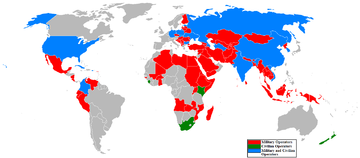
Picture - Mi-8 and Mi-17 operators
Military operators
Artillery observation, reconnaissance version.Civil variants
Mi-8T (NATO - Hip-C)
Civilian and military utility transport version, with accommodation for 24 passengers, fitted with tip-up seats along the cabin walls and circular cabin windows. The Mi-8T is powered by two 1,677-shp (1250-kW) Klimov TV2-117A turboshaft engines, giving the helicopter a maximum speed of 155 mph (250 km/h) at sea level.
Mi-8P
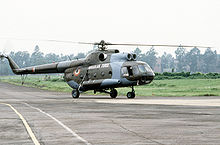
Picture - Indian Air Force's Mil Mi-8
Civilian passenger transport version, with accommodation for between 28 and 32 passengers, fitted with square cabin windows, powered by two 1,700-hp (1268-kW) Klimov TV2-117A turboshaft engines.Operators
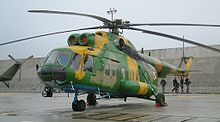
Picture - Polish Mi-8S
Afghanistan 65 have been acquired by the Afghan Air Force, with deliveries of 30 Mi-8 since 1971, and 35 Mi-17 since 1987. Albania 1 Mi-8T was acquired by the Albanian Air Force in 1996 from Ukraine. Algeria Angola Armenia 18 in service with the Armenian Air Force. Azerbaijan
Azerbaijan Air Force 13 in service.
Belarus
Bangladesh
43 Mi-17s and some Mi-8/Mi-8 MTVs in service
Bhutan
7 Mi-8s in service
Bosnia and Herzegovina
9 Mi-8T, 2 Mi-8MTV-1 and 6 Mi-17 in service
Bulgaria
18 Mi-8s in service
Burkina Faso
3 Mi-8s in service
Canada
6 Mi-8s leased for one year from Skylink Aviation
Cambodia
6 Mi-8/17s in service
Chad
4 Mi-171sh in service
China
250 Mi-8/17s in service
Colombia
30 Mi-17s in service
Croatia
15 Mi-8MTVs in service, 10 new Mi-171Sh entered service in 2007
Cuba
43 Mi-17s and some Mi-8/Mi-8 MTVs in service
Czech Republic
40 Mi-8/17s in service
Djibouti
3 Mi-8s in service
East Germany
East German Air Force, Volksmarine
Ecuador
Egypt
Egyptian Air Force 140 Mi-8s in service and 65 locally produced for special forces
Unit 777 24 Mi-8s
Ethiopia 12 Mi-8s in service Finland
Finnish Border Guard, former operator
Finnish Air Force, former operator
Finnish Army, All are taken out from service, 1 Stored or used for training purposes
Germany
Ex-East Germany
Georgia
18 Mi-8T/MTV helicopters in service
Ghana
Ghana Air Force
Guinea-Bissau
1 Mi-8T in service
Hungary
23 Mi-8 helicopters in service
Israel
1 captured Egyptian helicopter
India
134 Mi-8s in service of Indian Air Force
Iran
52 Mi-8/17s in service
Kazakhstan
Kenya
Used by the police for patrols acquired second hand in 2001
Kyrgyzstan
8 Mi-8s are in service of Iraq Air Force
Laos
Latvia
4 Mi-8/17MTV helicopters in service
Libya
Lithuania
5 Mi-8MTV in service
Macedonia
9 in service of Macedonian Air Force ; 4 in service of police
Madagascar
Malaysia
Montenegro
1 currently out of service
Mali
Mexico
Mexican Navy
Mexican Air Force
Policia Federal : Mi-8/17s are used by their special forces group GOPES
Moldova
8 in service
Mongolia
Mongolian Air Force
Mozambique
Myanmar
12 in service
Nepal
New Zealand
3 used in commercial logging operations
Nicaragua
4 in service
North Korea
Nigeria
4 Mi-8s in service
Pakistan
Peru
Poland
48 Mi-8/17s: Polish Air Force, Polish Navy and Polish Land Forces
Romania
Russia
Russian Air Force, Russian Naval Aviation and Russian Army Between 195 and 600 Helicopters.
Saudi Arabia
Senegal
Serbia
15 Mi-8s and 2 Mi-17s in service
Sri Lanka
Slovakia
Somalia
Soviet Union
Soviet Air Force, Soviet Army Aviation, Soviet Naval Aviation and USSR Border Troops. Passed on to successor states
Sudan
Syria
Syrian Air Force
Tajikistan
Turkmenistan
Uganda
Ukraine
Used by the Ukrainian Airmobile Forces, Ukrainian Air Force, Ukrainian Naval Aviation and Ukrainian Ground Forces
Uzbekistan
United States
Used by the 6th Special Operations Squadron for training
United Kingdom
2 currently in service, used to train Afghan pilots
Vietnam
Yemen
Yugoslavia
Passed on to successor states
Zambia
Civil operators
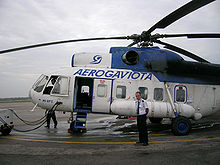
Picture - Aerogaviota Mi-8PS
Azerbaijan Azerbaijan Airlines (Mi-8T)
China Northern Airlines
Canada Skylink Aviation Colombia
Vertical de Aviacix³n
Helistar
Heliandes
Helicol
Cuba
Aerogaviota
Czech Republic
Mi-8 Aerocentrum
Estonia
Border Guard (retired), replaced by AW139.
Germany
German Police
India
Jagson Airlines
Malta
MAC (Malta Air Charter) which operated from the early 1990s to the end of 2004,
Mongolia
Mongolyn Alt (MAK) Corp (Mi-8T)
Maldives
3 Mi-8s were used by Hummingbird Helicopters in the 1990s. 2 were operated by Seagull Helicopters.
New Zealand
Heli Harvest (2x Mi-8MTV-1) based in Taupo
Soviet Union
Aeroflot
Russia
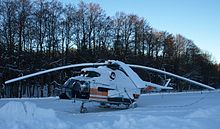
Picture - Estonian Border Guard Mi-8T (retired)
Aeroflot
Aerokuznetsk
Altay Airlines
Baltiiskie Avialinii
Barkol
Bel Kam Tour Kamtchatka, Jelisowo
Gazpromavia
Kazan Enterprise
UTAir
Vladivostok Air
Sierra Leone
Paramount Airlines
Tajikistan
Tajik Air
Slovakia
Air Transport Europe
South Africa
UTAir S.A.
Turkmenistan
Turkmenistan Airlines
United States
Blackwater Worldwide
Vietnam
Vietnam Air Service Company
Notable accidents
On 30 March 2008, a Russian Mil Mi-8T crashed at the Russian settlement of Barentsburg on Norway's Svalbard islands. The helicopter was attempting to land and struck a hangar, then crashed into the ground. Three of the nine people on board were killed in the accident.
Specifications (Mi-8T)
Data from Jane's All The World's Aircraft 1992-93
General characteristics
Crew: 3 (pilot, copilot, flight engineer)
Capacity:
24 passengers or
12 stretchers and seat for 1 medical attendant or
3,000 kg (6,600 lb) on internal/external hardpoints
Length: 18.17 m (59 ft 7 in)
Rotor diameter: 21.29 m (69 ft 10 in)
Height: 5.65 m (18 ft 6 in)
Disc area: 356 m² (3,832 ft²)
Empty weight: 7,260 kg (16,007 lb)
Loaded weight: 11,100 kg (24,470 lb)
Max takeoff weight: 12,000 kg (26,455 lb)
Powerplant: 2x Klimov TV3-117Mt turboshafts, 1,454 kW (1,950 shp) each
Fuel max total capacity: 3,700 l (977 US gal)
Performance
Maximum speed: 260 km/h (140 kt)
Range: 450 km (280 mi)
Ferry range: 960 km (596 mi)
Service ceiling: 4,500 m (14,765 ft)
Armament
up to 1,500 kg (3,300 lb) of disposable stores on six hardpoints, including 57 mm S-5 rockets, bombs, or 9M17 Phalanga ATGMs.
Related development
Mil Mi-14
Mil Mi-17
Mil Mi-24
Comparable aircraft
Aérospatiale Puma
CH-46 Sea Knight
Mil Mi-8 Pictures
Living Warbirds: The best warbirds DVD series.
Source: WikiPedia